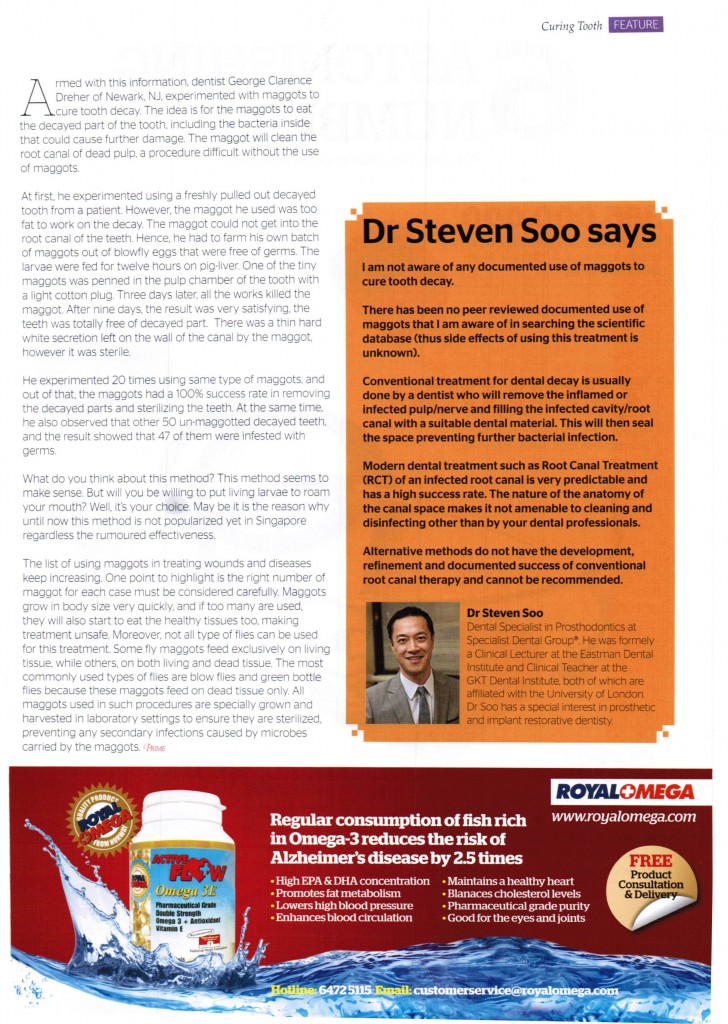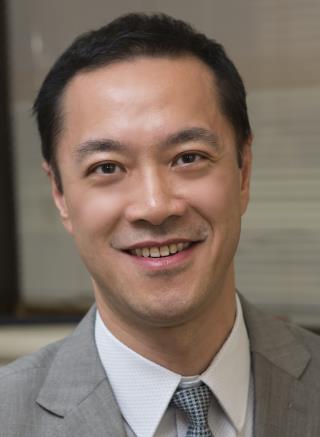 This article first appeared in the February March 2014 issue of Prime magazine. We have reproduced it for the information of those of you who missed it when it was published.
This article first appeared in the February March 2014 issue of Prime magazine. We have reproduced it for the information of those of you who missed it when it was published.
Dr Steven Soo’s take on curing tooth decay with maggot:
“I am not aware of any documented use of maggots to cure tooth decay. There has been no peer reviewed documented use of maggots that I am aware in searching the scientific database (thus side effects of using this treatment is unknown).
Conventional treatment for dental decay is usually done by a dentist who will remove the inflamed or infected pulp/nerve and filling the infected cavity/root canal with a suitable dental material. This will then seal the space preventing further bacterial infection.
Modern dental treatment such as Root Canal Treatment (RCT) of an infected root canal is very predictable and has a high success rate. The nature of the anatomy of the canal space makes it not amenable to cleaning and disinfecting other than by your dental professionals.
Alternative methods do not have the development, refinement and documented success of conventional root canal therapy and cannot be recommended.”
Maggot therapy or maggot debriment method has been used for centuries, including renaissance time. It is commonly used for treating wounds because maggots will eat the infected part of the flesh and disinfect the wound. Many surgeons have implemented this Baer technique to treat wounds and bone disease. It has been consistently shown that wounds infested with maggots heal better than those that are not.
Armed with this information, dentist George Clarence Dreher of Newark, NJ, experimented with maggots to cure tooth decay. The idea is for the maggots to eat the decayed part of the tooth, including the bacteria inside that could cause further damage. The maggot will clean the root canal of dead pulp, a procedure difficult without the use of maggots.
At first, he experimented using a freshly pulled out decayed tooth from a patient. However, the maggot he used was too fat to work on the decay. The maggot could not get into the root canal of the teeth. Hence, he had to farm his own batch of maggots out of blowfly eggs that were free of germs. The larvae were fed for twelve hour on pig-liver. One of the tiny maggots was penned in the pulp chamber of the tooth with a light cotton plug. Three days later, all the works killed the maggot. After nine days, the result was very satisfying, the teeth was totally free of decayed part. There was a thin hard white secretion left on the wall of the canal by the maggot, however it was sterile.
He experimented 20 times using same type of maggots, and out of that, the maggots had a 100% success rate in removing the decayed parts and sterilizing the teeth. At the same time, he also observed that over 50 un-maggotted decayed teeth, and the result showed that 47 of them were infested with germs.
What do you think about this method? This method seems to make sense. But will you be willing to put living larvae to roam your mouth? Well, it’s your choice. May be it is the reason why until now this method is not popularized yet in Singapore regardless the rumoured effectiveness.
The list of using maggots in treating wounds and diseases keep increasing. One point to highlight is the right number of maggot for each case must be considered carefully. Maggots grow in body size very quickly,and if too many are used, they will start to eat the healthy tissues too, making treatment unsafe. Moreover, not all type of flies can be used for this treatment. Some fly maggots feed exclusively on living tissue, while others, on both living and dead tissue. The most commonly used types of flies are blow flies and green bottle flies because these maggots feed on dead tissues only. All maggots used in such procedures are specially grown and harvested in laboratory settings to ensure they are sterilized, preventing any secondary infections caused by microbes carried by the maggots.
Dr. Steven Soo is a UK Prosthodontist at Specialist Dental Group®. He was formerly a Clinical Lecturer at the Eastman Dental Institute and Clinical Teacher at the GKT Dental Institute, both of which are affiliated with the University of London. Dr Soo has a special interest in prosthetic and implant restorative dentistry. For more information, visit www.specialistdentalgroup.com






